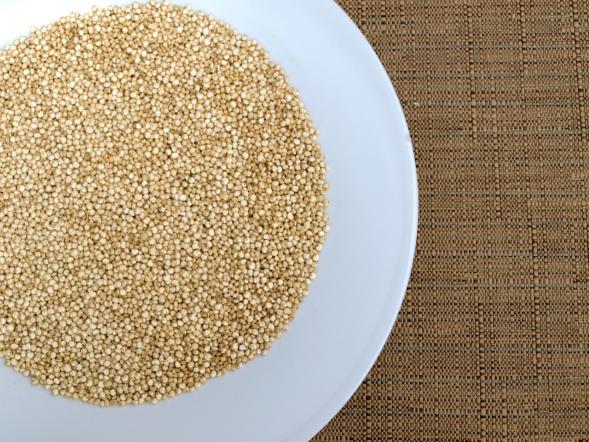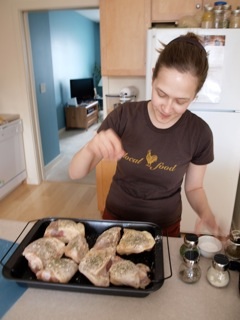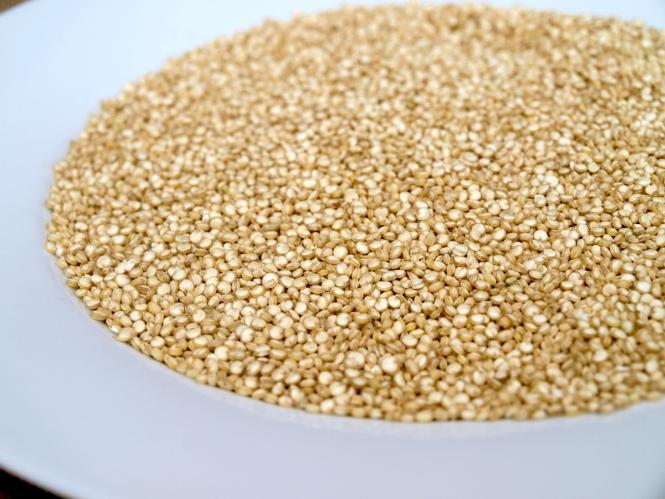This is the twelfth post in the series Great Grains, highlighting unusual whole grains and easy ways to incorporate them into your diet.
If quinoa had a résumé, I’m pretty sure that every one of us would have to hire it for whatever job it wanted. Ten seconds on Google pops up enough qualifications to make me wonder why I ever eat anything else:
“most-popular”
“supergrain”
“unmatched versatility”
“superfood”
“protein-packed”
“Grain of the Year”
“World’s Healthiest Food”
“The Mother of All Grains”
I even read that NASA is signing quinoa up to feed astronauts on long space flights. This may seem snarky but — seriously people? What is it with this stuff?
To me, quinoa is the cool kid on the playground right now. You know, the kid with an intentionally misspelled name, who is just too cool for obvious pronunciation (“No-no. It’s KEEN-No-aah”). The one who generally looks, tastes, and acts like all the other whole grain kids on the block but gets all the attention. The one that inspires us to post those “Hey…look at me and quinoa hanging in the kitchen” pictures on Facebook, just so all of our friends know that because quinoa is popular — we must also be popular.
Don’t get me wrong. I’ll buy it. I’ll cook with it. I’ll even order it on a menu. But what I won’t do with quinoa is claim that it’s any better than the options we’ve already got in our North American whole grain playbook. Call me condescending — but popularity contests are one of my biggest pet peeves in food. Eating what’s popular instead of what’s actually better tasting (or better for our food system) is how our we got into a mess in the first place. Large corporations spend billions of dollars each year telling us who the “popular kids” on the food block are. Unfortunately, most of these foods are processed, and high in fat sugar and salt. Unless we make a conscious choice otherwise, often what we put in our shopping carts and in our bodies has more to do with “popularity” than it does with good food.

When it comes to quinoa, many of us are familiar with the debate about how our new craving for quinoa is impacting economies in Central and Southern America where nearly all of the world’s supply is grown. Farmers who once relied on quinoa for a stable portion of their diet now find a volatile, garbled market with far more players. Reports went as far to say that the price of quinoa was so high in some markets, the farmers themselves couldn’t afford to buy their own product. Less nutritious and “junk foods” allegedly became so much cheaper in these markets, the farmers were forced to eat less healthy because we could pay more in the U.S. Some of these media claims about the harm to growers were inflated and later debunked. But still — the debate should make us wonder what lengths the rest of the world will go to when the American palate decides to go nuts-o for something new.
For now, quinoa and I have come to a standstill. I bought my first bag from the co-op at the start of the popularity boom in the blogging world a few years ago, cooked half of it and the rest has sat in the pantry until I pulled it out to write this post. At the time I just didn’t get what all the fuss was about. Plus it was pretty expensive compared to the other ingredients in my on-a-tight-budget shopping cart. It was only recently that I learned about the economic debate, and that hasn’t exactly helped the cause either.
Besides, there are plenty of other whole grains grown by local Midwestern farmers that closely match quinoa in flavor, texture, and nutrition. We may not grow the “perfect supergrain,” but writing this series has shown me the versatility of our regional grains. Ask yourself the next time you’re choosing the latest and greatest ingredient in the wide world of food: “Am I eating this because it’s really better than everything else? Or am I eating it because x, y, and z food blogs I love says it’s the best thing ever?”
I suppose that’s enough preaching to the choir. You all came here looking for quinoa info and recipe suggestions and are smart enough to make your family’s food choices without one more opinion muddying the water. If there’s more to say, I’d love to hash it out in the comments section below. So, as promised, here’s what we know about quinoa:

What is quinoa?
Quinoa (Chenopodium quinoa), like amaranth is not really a cereal grain in the same sense as oats or wheat. It’s a seed from a large plant grown mostly in the high mountain climates of countries like Bolivia and Peru. A few locations in the Rocky Mountains are starting to experiment with quinoa crops, but for now, the majority of the world’s supply is grown in South and Central America.
What’s great about it?
Although there are the ethical concerns mentioned above, quinoa really does win a nutritional gold medal. Unlike some of the other whole grains, quinoa is a “complete protein,” meaning it contains all of the amino acids we humans need to survive. For individuals on vegetarian or vegan diets, quinoa can be a healthy protein substitute. A complete review of the health benefits of quinoa can be found here.
Where can I find it?
By now most supermarkets, co-ops and health food stores have caught onto the quinoa craze and it’s now readily available in stores. Unfortunately, the quinoa craze has also meant its easier to find in the processed food aisles as well, especially in pre-boxed or frozen dinners. Beware that these meal options may be whole grain, but they’re also likely full of extra sodium and preservatives.
If you’re looking for raw or bulk quinoa, you’ll likely find three options: white, red and black. All have about the same nutrition, however the texture and flavor vary slightly. White quinoa is the most common and affordable choice, a good all-around choice. Red quinoa remains firmer and doesn’t turn as mushy after boiling; it tends to be a better choice for cold salads. Black quinoa has a similar color as wild rice, but is also the most rare and expensive.
What can I do with it?
If you’re looking for some new quinoa ideas, look no further than Simple, Good, and Tasty’s recipe archives. Here are a few from the great contributors here to get you started:
Deborah Madison’s Quinoa-Potato Croquettes – Merie Kriby
One Pot Kale and Quinoa Pilaf – Kristin Boldon
Quinoa Stuffed Peppers – Jeni Hill
Cauliflower Risotto – Rachel Huntzicker
Stir-Fried Quinoa with an Egg – Andy Cook
Orange Aioli with Quinoa and Roasted Beets – Jill Grunewald
Where do I learn more about quinoa?
And for more info on cooking quinoa, its health benefits, and the global debate about the damage to quinoa farming economies, check out these links:
Quinoa: March Grain of the Month
NYT’s “Quinoa’s Global Success Creates Quandary at Home”
Slate.com’s “It’s Okay to Eat Quinoa”

Amy Sippl is a frequent contributor to Simple, Good, and Tasty. She grew up in rural Wisconsin, but now calls St. Paul her home. She writes about her successes and struggles to eat and grow local food on her blog: Minnesota Locavore. She writes the Great Grains series for SGT; her last non-grain post for us was Co-op on a Budget: Your DIY Headquarters.

